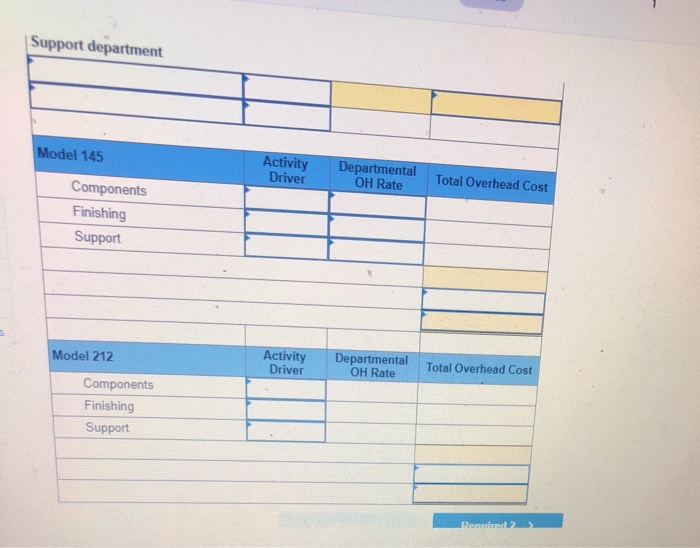Way Cool produces two different models of air conditioners. The company produces the mechanical systems in its components department. The mechanical systems are combined with the housing assembly in its finishing department. The activities, costs, and drivers associated with these two manufacturing processes and the production support process follow Process Components Activity Changeover Machining Setups Quantity 830 7.799 120 Finishing Welding Inspecting Rework Overhead Cost Driver 5454,800 Number of batches 307,000 Machine hours 229,000 Number of setups $ 990,000 $ 184,090 Welding hours 230, obe Number of inspections 64,000 Rework orders $ 478,000 $ 145,000 Purchase orders 33,500 Number of units 63,000 Number of units 5241,500 4,860 855 200 Support Purchasing Providing space Providing utilities 531 5.000 5.000 Additional production information concerning its two product lines follows Model 145 1.900 1.800 Model 212 2.100 3.000 Units produced elding hours Batches Sumber of inspections Wachine hours 360 2.450 REV 1 of 1 i! Nakt Process Components Activity Changeover Machining Setups Driver Number of batches Machine hours Number of setups Quantity 83e 7,790 129 Finishing Welding Inspecting Rework Overhead Cost $ 454,000 307,000 229,00 $ 990,000 $ 184,000 230,000 64,000 $ 478,000 $ 145,000 33,500 63,000 $ 241,500 Welding hours Number of inspections Rework orders 4,888 855 200 Support Purchasing Providing space Providing utilities Purchase orders Number of units Number of units 531 5,000 5,000 Additional production information concerning its two product lines follows. Model 145 1.900 1.300 415 495 Units produced Welding hours Batches Number of Inspections Machine hours Setups Rework orders Purchase orders Model 212 3.100 3,000 350 5.340 Do 11e 177 Required: 1. Determine departmental overhead rates and compute the overhead cost per unit for each product line. Base your overhead assignment for the components department on machine hours. Use welding department. Assign costs to the support department based on number of purchase orders. 2. Determine the total cost per unit for each product line if the direct labor and direct materials costs per unit are $210 for Model 145 and $190 for Model 212 3. If the market price for Model 145 is $1,625 and the market price for Model 212 is $250, determine the profit or loss per unit for each model Complete this question by entering your answers in the tabs below. Required 1 Required 2 Required 3 Determine departmental overhead rates and compute the overhead cost per unit for each product line. Base your overhead assignment for the components department on machine hours. Use welding hours to assign overhead costs to the finishing department. Assign costs to the support department based on number of purchase orders. (Round your intermediate calculations and per unit cost answers to 2 decimal places.) Components department Required 1 Required 2 Required 3 Determine departmental overhead rates and compute the overhead cost per unit for each product line. Base your overhead assignment for the components department on machine hours. Use welding hours to assign overhead costs to the finishing department. Assign costs to the support department based on number of purchase orders. (Round your intermediate calculations and per unit cost answers to 2 decimal places.) Show less Components department Finishing department Support department Total Overhead Cost Activity Driver Departmental OH Rate Model 145 Components Support department Model 145 Activity Driver Departmental OH Rate Total Overhead Cost Components Finishing Support Model 212 Activity Driver Departmental OH Rate Total Overhead Cost Components Finishing Support Recuired Complete this question by entering your answers in the tabs below. Required 1 Required 2 Required 3 Determine the total cost per unit for each product line if the direct labor and direct materials costs per unit are $210 for Model 145 and $190 for Model 212. (Round your intermediate calculations and cost per unit answers to 2 decimal places.) Model 145 Model 212 Materials and Labor per unit Overhead cost per unit Total cost per unit (Required 1 Required 3 > Complete this question by entering your answers in the tabs below. Required 1 Required 2 Required 3 If the market price for Model 145 is $1,625 and the market price for Model 212 is $250, determine the profit or loss per unit for each model. (Loss amounts should be indicated with a minus sign. Round your intermediate calculations and final answers to 2 decimal places.) Model 145 Model 212 Market price per unit Cost per unit Profit (loss) per unit













